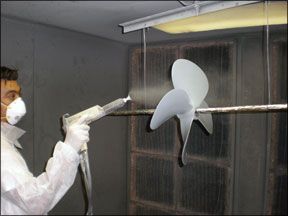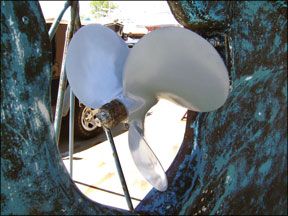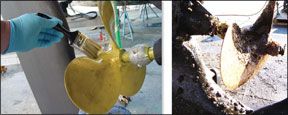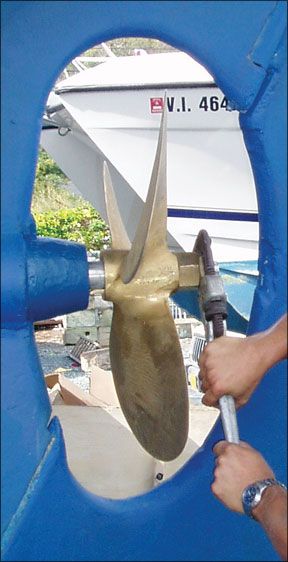A fouled bottom can slow a boat down. Worse, however, is a fouled propeller, which affects speed and also puts higher loads on the engine, decreases engine performance and efficiency, and impacts fuel economy. Over the years, Practical Sailor has tested and used multiple coatings to keep barnacles at bay on underwater metals, including props. Weve tried everything from diaper cream to specialized aerosol paints, and found none could keep a prop as fouling-free as the best copper paints kept our bottoms slick. (See PS, Feb. 1, 2004.)

Photo (top) courtesy of Mussel Buster; other photos by Frank Lanier
We define an ideal prop paint as one that is easy to apply, has good adhesion to metal, needs little maintenance, performs well (preferably for multiple seasons), and is readily available and relatively inexpensive.
In our search for the Holy Grail of prop paints, we delved into specialized multi-part coating systems. In the spring of this year, testers had Matrix Engineering Concepts Mussel Buster Prop Coating applied to the propeller of our Union 36 test boat. Prior to that, the prop had been the test platform for Oceanmaxs Propspeed, which we featured in the November 2006 issue.
In this report, we take a look at the newer product, Mussel Buster, and its application, and will weigh its pros and cons against other prop coatings.
As we put the Mussel Buster through its paces, we will be publishing updates on its performance, and we also plan to test other prop coatings like Prop Glop (www.moby-cool.com), Prop Shield (www.prop-shield.com), and Pettit Zinc Coat Barnacle Barrier (www.pettitpaint.com). If youve tried these, we welcome feedback from the field. E-mail us at [email protected].
MUSSEL BUSTER PROP COATING
Florida-based Matrix Engineering has patented a fouling-resistant coating based on powder-coating technology thats billed as an environmentally friendly way to keep a prop free of growth for years with light maintenance.

The company has spent 10 years testing and developing the Mussel Buster Prop Coating in both Florida and Lake Michigan waters. According to Matrix, Mussel Buster users routinely see product life cycles of two to three years, with some reports of up to four years. The coating “self cleans” during use. The degree of self cleaning is dependent on several factors (vessel use, speed, etc.), but in a nutshell, the faster and more often a boat cruises, the better the self-cleaning action and less maintenance is needed. Slower, infrequently used boats will require more regular prop scrubbing.
When that happens, Thygesen suggests, boat owners should simply slough off the spent layer with a Scotchbrite pad or fine-grit sandpaper to expose a fresh layer so it can keep on doing its job.
Mussel Buster is warranteed against total failure and some delamination or non-bonding of the coating to bare metal (excluding wearing due to cavitation) for one year following the date of application. Some erosion can be expected when there are cavitation issues, but that happens in only a small percentage of cases, according to Mussel Buster. Makers claim the coating does not “catastrophically fail” because of eroded areas thanks to its superior bond to the metal.
Mussel Busters performance claims sound too good to be true (and well find out if they are), but the coating is not without its drawbacks. For one thing, self-application is not an option-this actually can be a pro or a con, depending on your fondness for DIY boat work. Due to its unique and patented technology, Mussel Buster Prop Coating is not sold to the general public. It can only be applied by an authorized, certified applicator (a list of these is on the companys website), and its makers suggest having the prop scanned for optimization. Mussel Buster can also be applied to rudders, trim tabs, suction screens, and metallic bow thruster props-most anything except fiberglass or plastic surfaces.

Another factor to take into consideration is its total cost. The price is based on prop size and number of blades: Having a three-bladed prop 20 inches or less in diameter coated will run $150 plus tax, while a four-bladed prop 20 inches in diameter or smaller is $175 plus tax. Comparatively, most spray paints for props cost about $30 per 16 ounces, which will cover one application, and a Propspeed kit will run about $400 for a 37.75-ounce kit or $300 for 16.64-ounce kit. The Mussel Buster price does include the actual surface prep and application, where the other paint prices do not, however, youll also need to figure in removing the prop and transporting it to a certified Mussel Buster applicator.
The cheapest way weve found to keep a bronze prop in fairly clean condition is to burnish it well by wet-sanding with fine paper or a 3M wet-sand pad before launching the boat, and then scrubbing the blades and the hub two to three times a season.
Mussel Buster vs. others
Like Propspeed, Mussel Buster is billed as an environmentally friendly coating. Unlike some other antifouling coatings weve tested, the Mussel Buster application emits no VOCs. Two of the other metal antifoulings weve tested, Interlux Trilux Prop & Drive (PS, October 2008) and Pettits Alumacoat SR (PS, March 2009) arent quite as green: Trilux is an aerosol, contains 9 percent copper, and uses Irgarol as an anti-slime agent, while Alumacoat uses zinc omadine to discourage growth. Its hard to say at this early stage in testing how well the eco-friendly Mussel Buster will perform, but field reports from readers are encouraging.

Because Propspeed and Mussel Buster are more expensive per application than the others, wed expect the coatings to last longer. Trilux is a single-season paint, while Alumacoat is a multi-season; neither was found effective beyond the year-and-a-half mark during our tests. Our Propspeed test coating also was due for reapplication after about a year and a half, but that test was not indicative of the real-world results most users would have. (See below for details.) Mussel Buster claims a two- to three-year life expectancy, so watch for regular updates on its performance.
The most significant factor that sets Mussel Buster apart from other prop paints weve tested is its pro-only application. The Trilux and Alumacoat applications are easy and fast. Applying Propspeed requires more care and time as its a multi-step kit and includes mixing the two-part etching primer. But even with surface prep, Propspeed can be applied in a single day with re-launch eight hours later. Mussel Buster application takes two to three days (depending on prop size), not counting shipping time to and from the applicators shop.
Propspeed Update
Propspeed, a kit that includes a two-part etching primer and silicone-based top coat, prevents marine growth from attaching to the coated surface by being super slick. To keep that slick quality, the prop needs to see regular use.
We applied Propspeed to our test boats prop in March 2008. It saw some use that summer, and after six months, the coating was fully intact and clean. However, for the following year, the test boat was used very little and the prop was cleaned only once as testers waited to see what results complete neglect would bring. A year after application, testers noted some hard growth on the prop, and by October 2009, only about 85 percent of the coating remained and a re-application would be necessary.
Given the little use of our test boat, we can report that it doesn’t work longer than a season or two if your boat doesn’t move. We plan to re-test the coating as we test the new batch of prop paints on the market. Stay tuned for the report as well as updates on the long-term Mussel Buster evaluation.



































